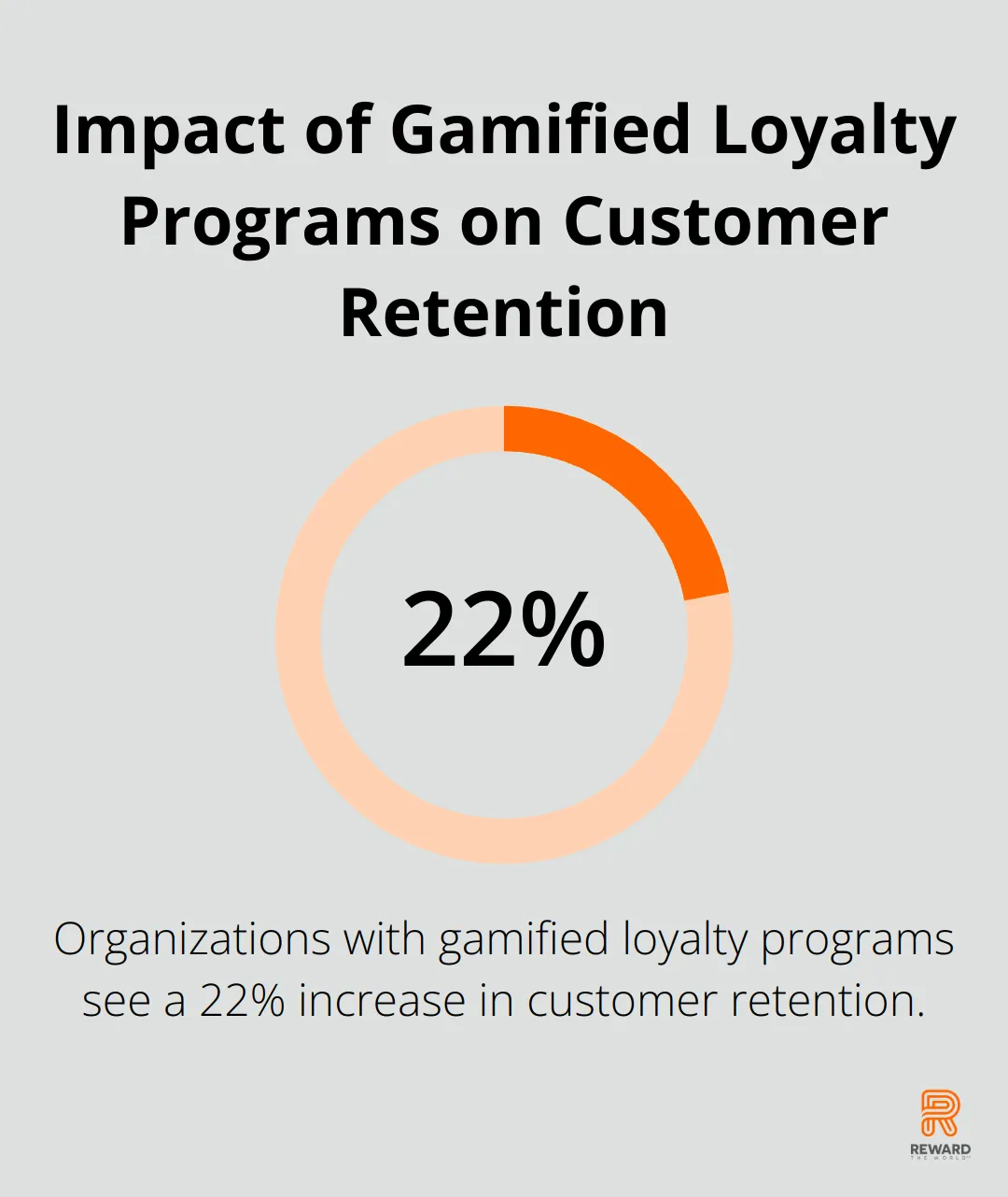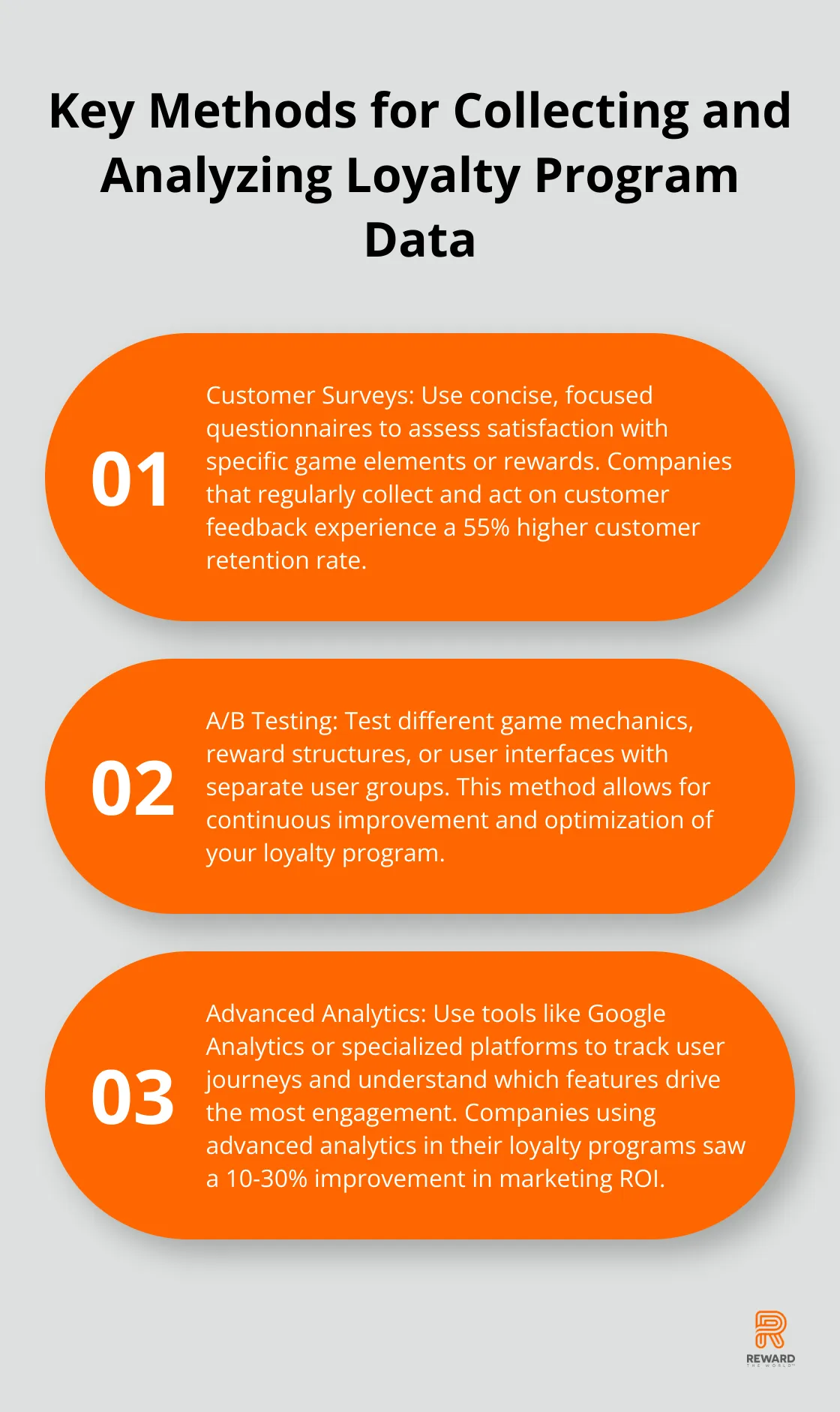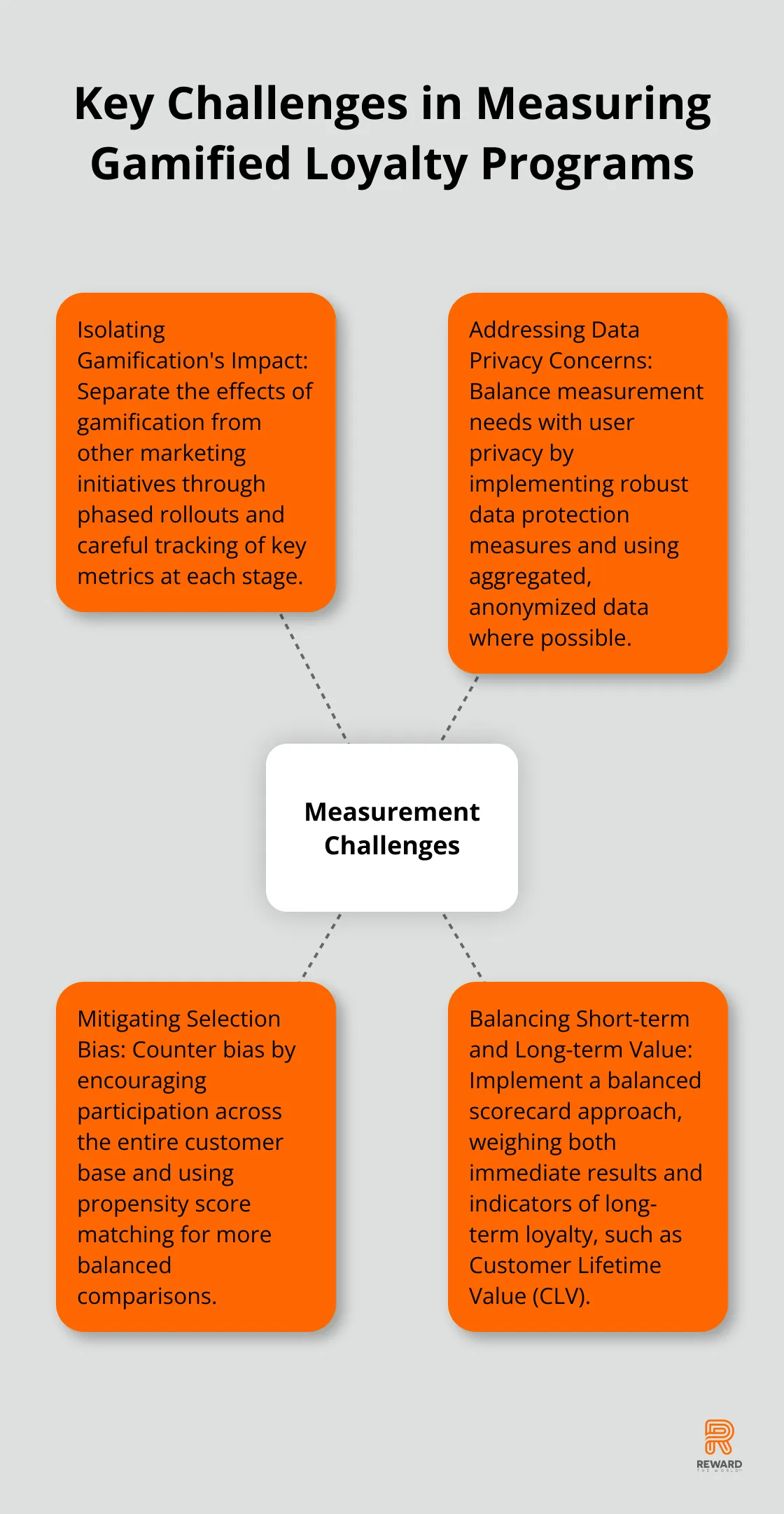
Gamified loyalty programs are reshaping customer engagement strategies, but how do we know if they’re truly effective? At Reward the World, we’ve seen firsthand the power of gamification in driving customer behavior.
However, measuring the gamification ROI requires a strategic approach. In this post, we’ll explore key metrics, data analysis methods, and common challenges in evaluating the impact of your gamified loyalty program.
What KPIs Matter Most for Gamified Loyalty?
Measuring the success of your gamified loyalty program requires a focus on specific Key Performance Indicators (KPIs). Four critical metrics provide a comprehensive view of program effectiveness.
Engagement: The Heartbeat of Your Program
Engagement drives any gamified loyalty initiative. Track daily active users (DAU) and monthly active users (MAU) to gauge how often members interact with your program. Monitor time spent in the app, frequency of logins, and completion rates for challenges or missions. These metrics reveal how compelling your program is and where you might need to adjust game mechanics.
Retention: Keeping Players in the Game
Customer retention directly impacts your bottom line. Calculate your retention rate by dividing the number of customers at the end of a period by the number at the start, then multiply by 100. Organizations with gamified loyalty programs see a 22% increase in customer retention, driving repeat purchases and strengthening brand loyalty. For gamified loyalty, pay close attention to how long users remain active after signing up. If you notice a drop-off after a certain period, introduce new challenges or rewards to keep the experience fresh.

Purchase Behavior: Turning Play into Profit
The ultimate goal of your loyalty program is to drive sales. Track average order value (AOV) and purchase frequency for program members versus non-members. Use your loyalty platform’s analytics to identify which game elements or rewards correlate with increased spending. This insight allows you to focus on the most effective strategies.
Social Proof: Amplifying Your Reach
In today’s connected world, social sharing can significantly amplify your program’s impact. Monitor mentions, shares, and user-generated content related to your loyalty program across social media platforms. Tools like Sprout Social or Hootsuite can help track these metrics. Encourage social sharing within your gamified experience to tap into this powerful marketing channel.
These four key areas – engagement, retention, purchase behavior, and social proof – will give you a clear picture of your gamified loyalty program’s performance. The goal is not just to collect data, but to use these insights to continuously refine and improve your program. Regular analysis of these KPIs will help you make data-driven decisions that enhance the user experience and drive business results.
Now that we’ve covered the essential KPIs, let’s explore the most effective methods for collecting and analyzing this valuable data.
How to Collect and Analyze Loyalty Program Data
Effective data collection and analysis are essential for measuring the impact of your gamified loyalty program. Here’s how you can gather and interpret data to gain actionable insights:

Utilize Customer Surveys for Direct Feedback
Customer surveys offer valuable direct feedback. Use concise, focused questionnaires to assess satisfaction with specific game elements or rewards. A study by Forrester Research shows that companies which regularly collect and act on customer feedback experience a 55% higher customer retention rate. Try to limit surveys to 5-7 questions to ensure high completion rates.
Employ A/B Testing for Continuous Improvement
A/B testing is a powerful tool to optimize your loyalty program. Test different game mechanics, reward structures, or user interfaces with separate user groups. For instance, testing two different point systems could reveal a 15% increase in engagement with the more intuitive system. Run tests for at least two weeks to account for novelty effects and ensure statistical significance.
Monitor User Behavior with Advanced Analytics
Behavioral analytics provide deep insights into how users interact with your program. Use tools like Google Analytics or specialized platforms to track user journeys, identify drop-off points, and understand which features drive the most engagement. A McKinsey study found that companies using advanced analytics in their loyalty programs saw a 10-30% improvement in marketing ROI.
Apply Machine Learning for Predictive Insights
Machine learning algorithms predict future user behavior based on historical data. This allows you to proactively address potential churn or identify opportunities for upselling. AI personalization can tailor messaging, product recommendations, and services to individual users. Start with one key metric (like churn prediction) before expanding to more complex models.
Data collection and analysis should be an ongoing process. Review your metrics regularly, adjust your strategies, and always prioritize data privacy to maintain user trust. These methods will equip you to measure and maximize the impact of your gamified loyalty program effectively.
Now that we’ve explored data collection and analysis techniques, let’s address some common challenges you might face when measuring the impact of your gamified loyalty program.
How to Overcome Measurement Challenges in Gamified Loyalty Programs
Measuring the impact of gamified loyalty programs presents several challenges. This chapter explores common hurdles and provides strategies to overcome them, ensuring accurate assessment of your program’s effectiveness.

Isolate Gamification’s Impact
One major challenge is to separate the effects of gamification from other marketing initiatives. A phased rollout of gamified elements allows for clearer comparisons.
Introduce a points system in month one, leaderboards in month two, and challenges in month three. Track key metrics at each stage to attribute changes to specific gamified elements. This method provides more accurate insights into the direct impact of gamification.
Address Data Privacy Concerns
With increased scrutiny on data collection, balancing measurement needs with user privacy is essential. Transparency about data usage and clear opt-in/opt-out options are key. Deloitte’s survey reveals that consumers have a positive perception of their technology experiences and are increasingly concerned about privacy and security.
Implement robust data protection measures and conduct regular audits of your data collection processes. Use aggregated and anonymized data where possible to minimize privacy risks while still gaining valuable insights.
Mitigate Selection Bias
Selection bias can skew results if your most engaged customers are more likely to participate in your gamified program. Counter this by encouraging participation across your entire customer base. Offer incentives for sign-ups and create low-barrier entry points to your program.
Use propensity score matching to compare program participants with similar non-participants. This statistical technique creates a more balanced comparison, providing a clearer picture of your program’s true impact.
Balance Short-term and Long-term Value
While short-term metrics like immediate sales boosts are tempting to focus on, consider long-term value as well. Track metrics such as Customer Lifetime Value (CLV) alongside short-term KPIs. Research by Bain & Company indicates progress and challenges in earning customers’ advocacy in an increasingly digital experience.
Implement a balanced scorecard approach, weighing both immediate results and indicators of long-term loyalty. Include metrics like repeat purchase rate, brand advocacy scores, and emotional connection to your brand.
Utilize Advanced Analytics Tools
To overcome these challenges effectively, use advanced analytics tools. Platforms like Reward the World offer robust analytics capabilities that help isolate gamification impacts, ensure data privacy, and balance short-term and long-term metrics. These tools provide comprehensive insights while maintaining user trust and data security.
Final Thoughts
Measuring the gamification ROI of loyalty programs requires a comprehensive approach. Key metrics such as engagement rates, retention, purchase behavior, and social proof provide valuable insights into program effectiveness. Data collection methods like customer surveys, A/B testing, behavioral analytics, and machine learning offer powerful tools to assess performance accurately.
Businesses face challenges in isolating gamification’s impact, addressing data privacy concerns, and balancing short-term gains with long-term value. Regular analysis of KPIs and swift adjustments based on data-driven insights ensure that loyalty programs remain effective and engaging. Advanced AI, machine learning, and blockchain technology will shape the future of loyalty program analytics.
Reward the World offers a comprehensive platform that combines analytics with instant rewards. Our solution helps businesses navigate the complexities of modern loyalty programs (providing tools and insights to drive customer engagement). As the loyalty landscape evolves, staying informed and adaptable will create programs that resonate with customers and deliver measurable business results.
